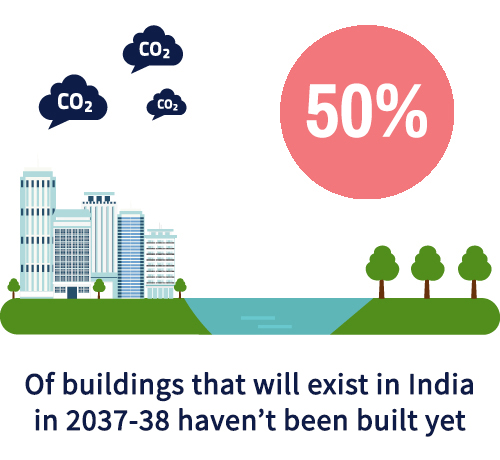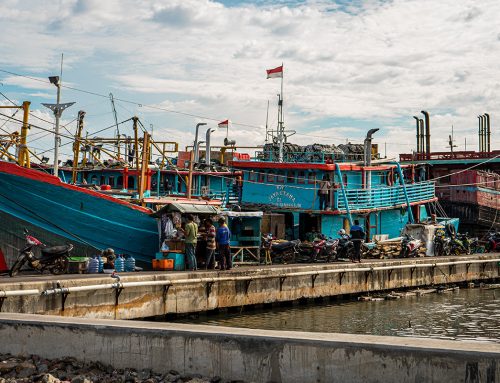Local partnerships preparing India to transform the way it builds
India is undergoing an urban transformation at a scale and speed that hasn’t happened anywhere in the world outside China. Experts estimate that 50% of the building stock that will exist in 2037-38 hasn’t been built yet1 and the country is expected to build 700 to 900 million square metres of residential and commercial space each year – equivalent to adding more than two Mumbais or one Chicago2.
GBPN is working together with local partners to support government and industry to meet CO2 emissions goals in India as they manage this intensive construction boom.
GBPN’s Senior Advisor in India, Gautam Nagar, said the timing has never been more right.
“The political will is there, the engagement from industry is there, the train is on the tracks. What we’re doing is making sure that when it pulls into the station, the platform is built and ready to receive it.”
– Gautam Nagar, GBPN Senior Advisor, India

According to India Cooling Action Plan and research by AEEE
The train, in this case, is mandatory sustainable building legislation that will ensure that new buildings don’t become massive carbon emitters, contributing to climate change for decades to come.
 Preparation work is critical, according to Dr Lee Siew Eang, GBPN Board member and Co-director of the Building Energy Efficiency Hub at the National University of Singapore (NUS). Speaking at a Theory of Change workshop on behalf of GBPN, he noted that one of the biggest barriers to implementing new policies that could positively impact climate change was a lack of effective public-private collaboration.
Preparation work is critical, according to Dr Lee Siew Eang, GBPN Board member and Co-director of the Building Energy Efficiency Hub at the National University of Singapore (NUS). Speaking at a Theory of Change workshop on behalf of GBPN, he noted that one of the biggest barriers to implementing new policies that could positively impact climate change was a lack of effective public-private collaboration.
“Government and Industry may have a will to work together but they also have to manage a lot of vested interests and conflicting priorities,” he said.
“What often happens is that new policies are developed and enacted before industry has any capacity to implement them and before governments have any capacity to enforce them. So then you have a five or six year lag while training and capacity building are developed to bring everyone up to speed.
“It’s far more effective if you can think ahead and prepare for all those requirements in advance so that when the legislation is passed, all parties can move swiftly into implementing it straight away. GBPN can play a role in providing an unbiased platform for collaboration to help make this happen. This is a real opportunity for GBPN to add value to the process.”
The time is right
 President and Executive Director of the Association for an Energy Efficient Economy (AEEE) in India and GBPN expert, Dr Satish Kumar, has been part of a co-creation process with GBPN to deliver clever solutions that understand local conditions.
President and Executive Director of the Association for an Energy Efficient Economy (AEEE) in India and GBPN expert, Dr Satish Kumar, has been part of a co-creation process with GBPN to deliver clever solutions that understand local conditions.
He said the country was poised for positive change and the passing of a bill to amend the Energy Conservation Act in August set the stage for real action.
“Climate change is an existential threat to the face of humankind, so we need to act urgently and act now. The passing of the Bill to amend the Energy Conservation Act, 2001, demonstrates the government’s commitment and the country’s seriousness towards its sustainable development goals,” Dr Kumar said.
“The bill is rightly expanding the coverage of energy efficiency to include large residential buildings. In anticipation of the upcoming need, AEEE has been working to develop a tool that will help industry and policymakers to implement improvements at the design stage that will deliver increased thermal comfort and renewable energy to achieve a net-zero paradigm.
“The tool is also intended to offer developers and designers a vision of how sustainable building practices can be integrated into their designs in a practical and affordable way.”
Strong partnerships the key to success
The AEEE project is one of many such projects in India that have emerged from this co-creation approach. Executive Director Dr Peter Graham, said the strategy was crucial to success in countries like India.

Dr Peter Graham, CEO and Executive Director, GBPN
“GBPN is scaling up by using a bottom up approach – which has been part of the organisation’s DNA since the beginning,” Dr Graham said.
“We begin by identifying local experts and organisations that are trusted in policy reform and working with them to develop reform strategies that are responsive to local conditions.”
He said involving local experts in designing the work ensured the solutions developed would be practical, easy to implement and affordable – removing many of the existing barriers to delivering sustainable building practices.
“The approach isn’t to find out what should be done in India, call for proposals and then offer funding for a project,” Dr Graham said.
“We identify the right partners and then we ask them, how are we going to do this? What do you think is needed? Where should we place the emphasis? Then we give them the opportunity to exercise their expertise and really do what they do best.”
Part of a portfolio of projects managed by Monash University/MADA, host of the GBPN Asia-Pacific Office.
- India Cooling Action Plan and research by AEEE.
- McKinsey Global Institute, 2010.
Find out more about GBPN’s Projects in India:





